Posted by Elena del Valle on June 13, 2012

Direct mail credit card offers – click to enlarge
Chart: Mintel Comperemedia
Some researchers believe credit card offers are a reflection of the economic health of the country. In June 2011, there were 497 million credit card direct mail offers nationwide, a healthy number. By April of 2012 the number was down to 260 million, reflecting a 33 percent drop in direct mail offers for new credit cards between April 2011 and April 2012. In other words in April of this year, United States households received an estimated 260 million credit card offers while a year earlier they received 390 million offers. This may be the lowest estimated monthly mail volume tracked in the past 25 months, according to Mintel Comperemedia.
“Issuers have adopted a more cautious approach due to an uncertain economic environment. The latest downturn likely reflects a pause in activity rather than signifying a permanent reduction in direct mail,” said Andrew Davidson, senior vice president at Mintel Comperemedia. “Credit card direct mail volume will be significantly lower in 2012 than 2011. For credit card issuers this is a great time to be in the mail. The mailbox is less cluttered and it is easier to get consumers to notice your message.”
Because direct mail offers for credit cards are cyclical mailings likely reflect market trends and Dow changes, and since other marketing channels, such as online and social media, are not replacing direct mail the mailings are likely to return to high levels once the economy recovers, he believes.
Posted by Elena del Valle on June 11, 2012

The Scent of Departure Paris
Photos: The Scent of Departure
Ever want to visit Singapore, Budapest or Istanbul but didn’t get a chance? Or perhaps you visited those exotic cities and want to reminisce about your trip? A new perfume line, launched in 2011, promises scent lovers the essence of those cities and 17 others including three in the United States in a $45 1.7 ounce bottle. If blood orange, sweet orange, lemon, yellow tangerine, pink grapefruit, lotus flowers, freesia, lilac, orange jump, white musk, blonde wood, vanilla, and caramel remind you of Miami you are in luck. Those are the ingredients in the line’s Miami eau de toilette fragrance.
Caramel can also be found in New York if the perfume makers are to be believed. In addition to caramel they made that city’s namesake fragrance with green and crispy apple, juicy apple, lotus flower, jasmine, lilac, rose petal, caramelized apple, white musk, and vanilla. Tokyo on the other hand smells like lemon, bergamot, green stem, lotus flower, freesia, ozonique flowers, peony and white musk, according to them.
This could be a good time to introduce such a line, allowing it to be in place for the year’s Christmas holidays which, according to Mintel, is when most perfume buying takes place in the country. Perfumes and products with fragrances seem to be popular among United States consumers. In a survey last year, many (29 percent) domestic consumers said they bought someone a fragrance (25 Stocking Stuffers from Mintel, Holiday Shopping U.S. July 2011 and Seasonal Chocolate U.S. August 2011 Mintel survey reports). In 2005, the average annual consumer spending of Consumer Units (there were 2.5 persons per Consumer Unit; Consumer Unites appear in 000s) on cosmetics, perfume and bath products was 132.31 (Household Spending 12 Edition), the highest segment by far of the Personal Care Products category.

Magali Senequier and Gerald Ghislain
Gerald Ghislain, perfumer, and Magali Senequier, his creative partner, used the IATA (International Association of Travel Agents) assigned three letter airport codes for 20 cities to name The Scent of Departure line which, according to a company spokesperson, is made in Paris, France. They selected cities they had visited and liked for the line targeted at “men and women who love to travel or discover trendy and atypic products,” according to the spokesperson. Prior to this line they launched Histoires de Parfums.
The fragrance is contained in a slender glass bottle sporting the letters for that city with a design inspired by a luggage tag with the three IATA code letters of the city that it represents. The initial scents are: Paris (CDG), London (LHR), Milan (MIL), Frankfurt (FRA), Munich (MUC), Keflavik (KEF), Istanbul (IST), Budapest (BUD), Vienna (VIE), New York (NYC), Los Angeles (LAX), Miami (MIA), Dubai (DXB), Abu Dhabi (AUH), Doa (DOH), Singapore (SIN), Tokyo (TYO), Hong-Kong (HKG), Seoul (ICN) and Bali (DPS). The company plans to sell the line at airports, large retail stores, Henri Bender in New York and at its website, thescentofdeparture.com.

The Scent of Departure Los Angeles
If as Jennifer Dublino, chief operating officer, Scent Marketing Institute, said “Scent is particularly important to Latinos, even more so than to other cultural groups,” (see Scent Marketing Connects to Hispanics on a Deep Cultural Level) this new line could appeal to Latino consumers in the United States and Latin America.
It is noteworthy that the three cities in the United States included in the line, Los Angeles, Miami and New York City, have some of the largest pockets of Latinos in the country. Some might wonder if the inclusion of well liked cities like Paris and London will make up for the absence of Latin American cities in the line. Will the oversight displease United States Latinos? Will Latinas who, according to Dublino, use fragrance products much more frequently than non-Latinas because they are an important part of their feeling of femininity, respond to the marketing concept of the line?
Posted by Elena del Valle on June 8, 2012
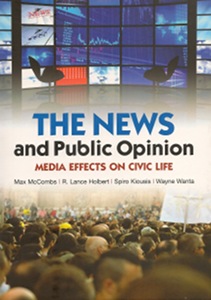
The News and Public Opinion book cover
Photos:R. Lance Holbert, Wayne Wanta, Spiro Kiousis
Four academics, Max McCombs, R. Lance Holbert, Spiro Kiousis* and Wayne Wanta, discuss the effects of news media (print, television and radio) on public opinion in The News and Public Opinion Media Effects on Civic Life (Polity Books, $22.95). In the 210-page softcover book published in 2011, they address the public’s attention to news media, effects of media exposure on the gathering of information and forming of attitudes and opinions, and how these elements affect public life or how the process affects public opinion.
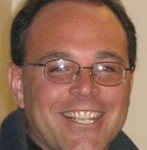
R. Lance Holbert, co-author, The News and Public Opinion
The authors point out that some media are suffering financially. In relation to news they refer to how the television networks news programs have decreasing audience numbers which have led to a loss of profitability and power. Soft news programs are more profitable and the networks remain focused on making a profit; also, older men are the most likely to watch network news programs and a young demographic is not following in their footsteps, they say.

Wayne Wanta, co-author, The News and Public Opinion
Cable news networks like CNN and Fox News have a role as well. Fox News viewers, according to a study by Jonathan Morris, were not was well informed as the viewers of other television news programs, followed specific voting patters, held specific political views and had a political perspective distinct from viewers of other news networks.
Public trust of news media is very low and entertainment content within public affairs has become popular because “the present practice of journalism is so poor,” the authors say in the first chapter. Citizen involvement in journalism has been greatly enhanced, and continues through the internet; the audience of news media is decreasing and to reach them segmentation, including by ethnicity and language, has become increasingly necessary, the authors say. In the Audiences for News chapter, they indicate their belief that ethnic-based news media will continue to grow.

Spiro Kiousis, co-author, The News and Public Opinion
Education plays a role in learning from the media and people with high levels of education learn more and at a faster rate than their counterparts with low educational levels, according to the authors who discovered that newspaper readers learn more than television audiences. Gender also plays a role, they believe, with men favoring hard news and women favoring soft news. The authors also discuss media selectivity and the importance of form versus content.
*Elena del Valle and Spiro Kiousis serve on the University of Florida Public Relations Advisory Council.

Click to buy The News and Public Opinion
Comments:
Filed Under: Books
Posted by Elena del Valle on June 6, 2012

H1N1 3D graphic representation of a generic influenza virion’s ultrastructure
Illustration, graph: Dan Higgins, CDC
In spite of all the commotion around exotic diseases like the West Nile Virus, H1N1 flu, salmonella and others that have received extensive media coverage infectious diseases account for a fraction of deaths in the United States. Sellers of funeral services, insurance, health care or end of life related products may be interested to know that world wide 56 million people die every year many from cardiac disease or cancer. Those two causes of death accounted for more than half (63 percent) of all deaths in 2008, according to the World Health Organization (WHO).
In the United States, about half of the adult population has a chronic condition like diabetes. According to the CDC (Centers for Disease and Control Prevention), the top five causes of death in 2009 were heart disease (599,413), cancer (567,628), chronic lower respiratory diseases (137,353), stroke (128,842), and accidents (118,021).
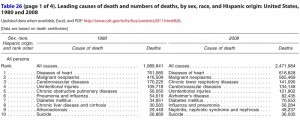
U.S. Causes of Death 1980, 2008 – click to enlarge
In 2008, 139,241 Hispanics died; the top 10 causes of death for Hispanics in Health, United States, 2011 (Table 26) , the most recent CDC report, were: diseases of heart (28,951), malignant neoplasms (28,851), unintentional injuries (11,080), cerebrovascular diseases (7,121), Diabetes mellitus (6,544), chronic liver disease and cirrhosis (4,091), chronic lower respiratory diseases (3,949), homicide (3,331), influenza and pneumonia (3,176), and Alzheimer’s disease (3,005).
In OECD (Organization for Economic Co-operation and Development) countries, (the United States is an OECD member) nearly one quarter of the population (22 percent) will be 65 years old or older by 2030. In contrast young people in developing countries are more likely to die from infectious diseases. If they survive into middle age the common killers, cancer or cardiac disease, become the more likely causes of death.
Posted by Elena del Valle on June 4, 2012

Click to enlarge
Graphic: HispanicMPR.com
Are you marketing or selling a new product in the United States? Speed may be of the essence. For 40 years innovation has, at least in part, fueled our growth in the United States. In the 1990s, rapid innovation made it possible for our economy to grow at a quick pace and prompted the creation of new jobs while old ones were lost due to higher production efficiencies and cheap labor costs overseas. Recently, that process appears to have broken down. While the flood of jobs to developing countries continues the pace of innovation has slowed and the amount of time during which manufacturing and selling new products remain profitable within our country is shorter, according to Pinched.
Knowledge, business know-how and research and development become less valuable more quickly today than they did 15 years ago, according to economist Michael Mander (see A Massive Writedown of U.S. Knowledge Capital at innovationandgrowth.wordpress.com). Some people believe improved and inexpensive international communication and a diverse international workforce have played a prominent role in the loss.
The more people, companies and countries have access to knowledge the less valuable it becomes. As communication has improved so has the flow of information and knowledge, reducing the value of the knowledge more quickly in the countries where it was developed (often the United States and Europe) and shifting the know-how to other countries with greater efficiency than in past decades, say the experts.
Too much red tape and corporate power has dramatically decreased new inventions (see Patent attorney explores reduction of inventions in America). With fewer inventions patented and a faster rate of knowledge capital depreciation (which results from the expenditures of an organization that have led it to increase efficiency over time according to Paul Strassman at Strassman.com) the importance of our skilled scientists and business professionals has grown, these economy analysts believe. Is it possible that developing marketing plans and timelines to match the changing marketplace may make a big difference in extending the timeline of profitability and keeping knowledge capital depreciation in check?
Posted by Elena del Valle on June 1, 2012
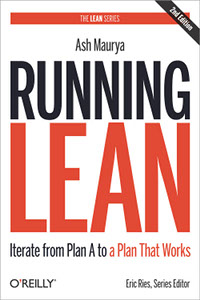
Running Lean book cover
Photos: Newman Communications
Ash Maurya, who has launched several start up companies, is convinced that most new products fail because those that launch them waste energy and resources on the wrong product. Figuring out what products to introduce into the market and how can be done by developing a plan, identifying the high risk parts of the plan and repeatedly testing the plan, he believes. In the second edition of Running Lean: Iterate from Plan A to A Plan That Works (O’Reilly, $24.99), published March 2012 as part of The Lean Series, he explains his thinking on the topic.
The book, written for entrepreneurs, business managers, senior executives, small business owners and anyone seeking to start a business project, presents a process he thinks optimizes the way to quickly outline and define good product ideas, maximizing the chances of success. Most product launches that succeed are ones that adjust their plans before they run out of resources, according to the book.
In the book, Maurya sets out to provide detailed tactics on ways to figure out what potential customers want, how to conduct a good customer interview, addressing issues such as finding the prospects and overcoming mental blocks when speaking to them. Talking to people is important, according to the author who thinks that running surveys and focus groups may seem more efficient than interviewing customers, but isn’t the best approach.

Ash Maurya, author, Running Lean
The 206-page hardcover book is divided into four parts: Roadmap, Document Your Plan A, Identify the Riskiest Parts of Your Plan, and Systematically Test Your Plan; and 15 chapters. Maurya, founder, Spark59, has worked closely with entrepreneurs, assisting them to test and fine tune their vision.
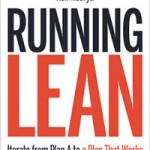
Click to buy Running Lean
Comments:
Filed Under: Books
Posted by Elena del Valle on May 30, 2012
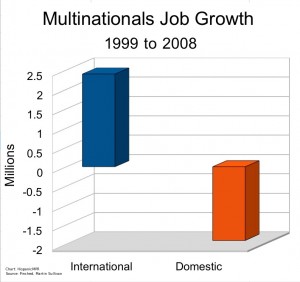
Multinationals Job Domestic and International Growth 1999-2008 – click to enlarge
It used to be that the pace of innovation kept employment numbers strong in the United States. As some jobs became obsolete and migrated overseas workplace evolution and new technologies resulted in the creation of new jobs that outpaced the losses. Over time, as innovation slowed, more jobs migrated out of the country than were created and access to cheap international human resources and continuous corporate desires for profit continue to fuel the trend with few or no tax consequences to stem the job losses.
In 2007 multinational companies employed 19 percent of the private sector workforce, earned 25 percent of private sector profits and paid 25 percent of private sector wages. For all their impressive presence and efficiency these companies were not noteworthy on the job creation side, according to a 2010 McKinsey Global Institute report cited in Pinched.
In the last 20 years, multinationals have been responsible for 41 percent of labor productivity in the United States corresponding to only 11 percent growth of employment in the private sector. The production cycle many relied on meant initial production in wealthy nations with abundant innovation that eventually moved to countries with lower labor costs. In the United States, hardware manufacturing and data processing jobs shrunk when both were expected to grow.
At the same time, and especially during the Great Recession, companies pushed for greater efficiency, driving staff to work longer hours and accomplish more with less. Some developed new processes and methodologies and others accomplished their efficiency goals by squeezing more hours and labor out of employees who feared for their jobs and way of life in a declining economy. These strategies have led to greater stock value for publicly traded companies and higher profitability for many companies overall at the expense of jobs lost that will likely never be recovered. Fewer jobs lead to a slower economy with consumers holding back and focusing on savings. This is especially true when prospective employees are trapped where they are living due to the lingering housing bubble.
An example of the trend is that between 1999 and 2008 multinationals in the United States cut back domestic employment by 1.9 million while boosting foreign employment by 2.4 million, according to economist Martin Sullivan (see Pinched and U.S. Multinationals Moving Jobs to Low-Tax, Low-Wage Countries at Tax.com). At the same time, the figures that reflect a domestic decrease in jobs do not appear to include loss of revenue domestically for individuals who suffered salary and benefits cuts by their multinational employers.
Posted by Elena del Valle on May 25, 2012
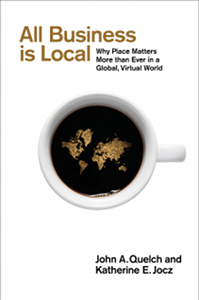
All Business Is Local book cover
Photos: Portfolio/Penguin, John Quelch and Katherine Jocz
I first heard about a chain of healthy fast food restaurants through a colleague across the country. Because of her high endorsement I tried the one nearest to me and liked it. Over time the food and service declined noticeably. I, and many others who used to stand in line there, stopped going. It doesn’t matter how popular the chain remains at the national level I no longer patronize it because the local restaurant is not to my liking. This might be what experts refer to when they say location matters.
Businesses, regardless of their size, must be local and global in order to thrive, according to John Quelch, dean, China Europe International Business School (CEIBS), and Katherine Jocz, a marketing consultant. In their book, All Business Is Local: Why Place Matters More Than Ever in a Global, Virtual World (Portfolio/Penguin Group USA, $25.95), published this year, John Quelch and Jocz explain their reasoning.

Katherine Jocz, coauthor, All Business Is Local
Too often companies focus on a global market and neglect local aspects, they say. The authors believe people shop at the stores that make sense to them regardless of the global efforts or reputation of the company that owns them or the brand. Location matters now more than ever, according to them. Place, they say in the Introduction, is “one of the most reliable bases for targeting and positioning decisions.” They stress that the more connected we become worldwide the more we will want to focus on local rather than global.

John Quelch, coauthor, All Business Is Local
Global brands like Real Madrid, Starbucks and McDonald’s are often local favorites because of their ties to the communities where they are located; adapting selections and menus to local tastes, buying locally, and employing locally are some of the strategies successful companies rely on, the authors say in the book.
The 248-page book is divided into one Introduction and five chapters: Managing Psychological Place, Managing Physical Place, Managing Virtual Place, Marketing Geographic Place, and Marketing Locally and Globally. Quelch was formerly associate dean of the Harvard Business School and dean of the London Business School. Jocz was formerly a research associate of the Harvard Business School and a director of networks and relationships at Marketspace.
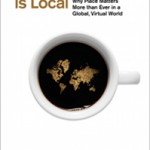
Click to buy All Business Is Local
Comments:
Filed Under: Books





























